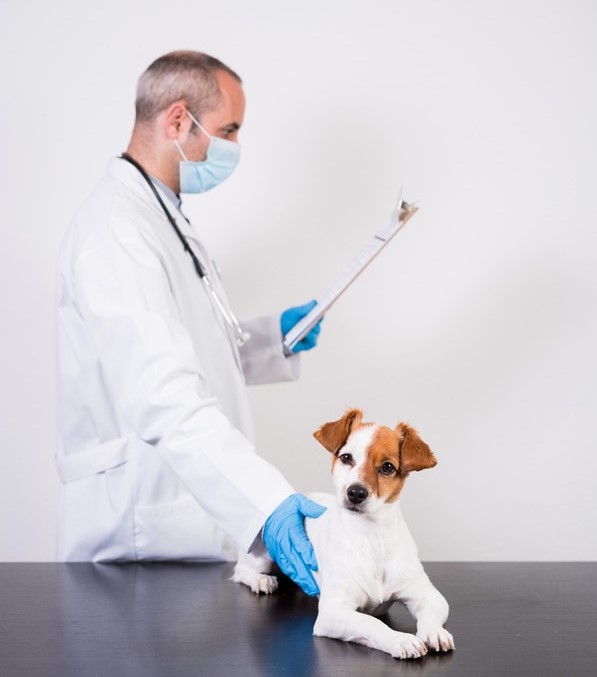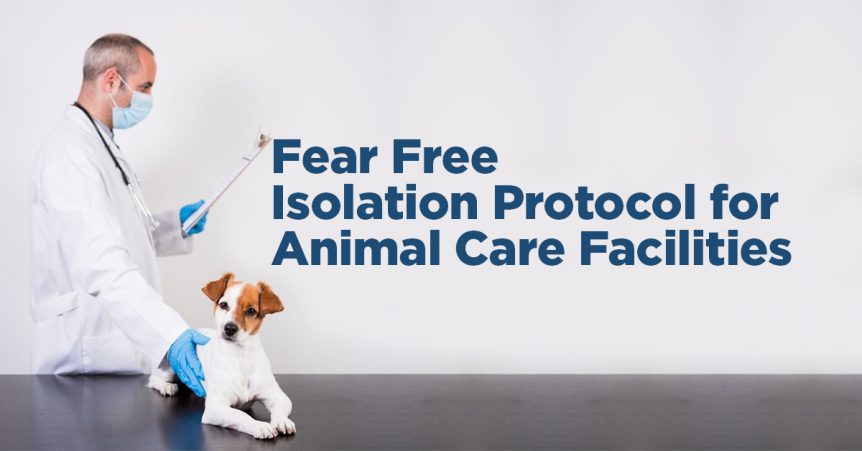When pets suspected of being infectious are brought to your clinic, it’s important not only to have an isolation area for them to protect other patients but also to make that isolation area and interactions taking place in it comfortable for the patient. The following isolation protocol will keep patients and people safe and help infectious or potentially infectious patients to remain calm. It includes using disinfectants that are not aversive to patients, using cleaning techniques that help the patient remain comfortable, and adjusting body movements to avoid scaring patients. Species-specific pheromones and calming music composed for animals can also help to enhance their stay. The goal is to create an isolation experience that incorporates considerate approach to minimize fear, anxiety, and stress (FAS).

When a patient suspected of being infectious is brought to the clinic
- Ideally, your clinic will have a separate entrance where potentially infectious patients can enter without encountering other animals. If not, ask pet parents to wait in the car with the pet until they can be taken directly to the isolation area.
- Put on appropriate PPE (gown, gloves, mask, etc.) before making contact with the patient. The extent of PPE required will depend on the mode of transmission of the potential pathogen. Remember that people wearing PPE can look scary to patients. Try to reduce their fear by approaching slowly and not looming over them. If possible, kneel to greet them.
- Using the isolation entrance, carry the patient to the isolation area or transport the patient on a gurney with a non slip surface and a disposable cover.
- After the pet has been placed in the isolation area, clean and disinfect all surfaces that have come into contact with the patient, using Rescue Wipes, Ready-to-Use Liquid, or Concentrate*. While the patient remains in the isolation area, spot clean as needed so that some familiar scents remain rather than cleaning the entire area and completely removing comforting odors.
- *If the presence of a certain pathogen has been confirmed, follow the appropriate use directions on the Rescue product label. If the pathogen is unknown, use a dilution ratio of 1:16 (8 oz. per gallon).
Caring for patients in isolation areas
- Before entering isolation area, remove outerwear—such as your lab coat as well as any equipment or accessories (e.g., stethoscope, scissors, thermometer, watch, cell phone)—and leave outside the isolation room.
- Do not bring treatment sheets, pens, or electronic devices like laptops, cell phones, or tablets into the isolation room.
- Gather necessary supplies and medications before putting on PPE. Ideally, patients who require isolation precautions will have dedicated equipment.
- Wash hands and then put on booties, gown, and gloves before entering isolation room. Avoid using instant hand sanitizer, which has a strong, lingering odor that most animals find unpleasant.
- Attend to the patient in isolation as needed. Approach gradually, turning to the side or bending down to greet them so you seem less threatening. If the patient is able, wait and let them approach you to sniff. Speak in calm, soothing tones and minimize sudden, loud, or startling noises. Exam tables should have non slip surfaces that can be easily disinfected or removed for cleaning. For cats and puppies, visual blocks or hiding spots can increase their comfort level.
- Using Rescue Wipes, clean and disinfect any equipment used while caring for the patient.
- Before leaving isolation room, remove PPE. Place used disposable PPE in trash container lined with biohazard bag in isolation room. DO NOT SAVE DISPOSABLE PPE FOR REUSE. Take off booties last while stepping out of the isolation room and avoid touching outer surface of booties. Avoid contact with external portions of door when exiting isolation room.
- Clean and disinfect non-disposable PPE (e.g., eye protection) using Rescue Wipes or Ready-to-Use Liquid.
- Wash hands with soap and water. Then, using Rescue Wipes, disinfect any surface that may have accidentally been contaminated when exiting the room, such as doorknobs. Make any needed chart entries. Wash hands again before leaving the room as needed.
Cleaning and disinfecting isolation area
After each patient is discharged, take the following steps to clean and disinfect the area using Rescue Concentrate:
- Remove all items prior to cleaning and disinfection. Pre-clean visible soil from surfaces.
- Apply Rescue Concentrate evenly to all patient contact surfaces and allow to remain wet for the required contact time.
The ideal disinfectant for isolation areas
Although often necessary, being placed in isolation units can be stressful for animals. The disinfectant used should be effective against potential pathogens without adding to the fear and anxiety associated with the isolation experience. The ideal disinfectant for use in these areas should meet the following criteria:
- Effective against a broad spectrum of pathogens, including hard-to-kill viruses (e.g., canine parvovirus) and fungi like ringworm. This will give you confidence that the disinfectant will be effective against unknown pathogens that may be brought into your facility. Many commonly used disinfectants, such as those formulated with quaternary ammonium compounds, are thought to be less effective against these harder-to-kill organisms.
- Non-irritating and gentle on animals and humans. The disinfectant should not carry any GHS hazard classifications or warning labels at the in-use concentration and should not have harsh chemical odors.
- Effective in rapid and realistic contact times. This helps achieve disinfection compliance in a single application and streamlines isolation protocols.
- Effective as a cleanser as well as disinfectant. The many odors associated with isolation areas or the veterinary facility in general can contribute to stress. Using a disinfectant with proven cleaning capabilities can help wipe out odor-causing compounds and create a calmer experience for the animal.
- *If the presence of a particular pathogen has been confirmed, follow the appropriate use directions on the Rescue product label. If the pathogen is unknown, use a dilution ratio of 1:16 (8 oz. per gallon).

